#myer briggs
Text
INFP: *gently taps table*
INTP: *taps back*
INFJ: What are they doing?
INTJ: Morse code.
INFP: *aggressively taps table*
INTP: *slams hands down* YOU TAKE THAT BACK-
#source: ???#mbti incorrect quotes#incorrect mbti quotes#16 personality types#mbti#mbti types#incorrect mbti#meyers briggs#infp#mbti infp#intj#mbti intj#infj#mbti infj#intp#mbti intp#myer briggs
1K notes
·
View notes
Text
My take on the MBTI from the perspective of an ENTJ
1. ENTP: Smart, fun people; easy to get along with.
2. INTP: I want a piece of your mind.
3. INTJ: Cool and mysterious, but the males are annoying
4. ENTJ: Hyperfocused on success to the point that it's unhealthy
5. ENFJ: The chronic need to be the center of attention is excusable because y'all have a good heart
6. ENFP: Y'all put too much effort into acting like you don't care if you're liked by everyone for being "quirky", but you do.
7. INFP: Pathetic; really need to stop letting people walk all over themselves
8. INFJ: Sage wisdom, kind heart
9. ISFJ: Lowkey boring ngl
10. ISFP: You make sure to stand out in your own ways
11. ESFP: Annoying, self-indulgent, the lack of awareness is ghastly. Often wonder what it is like to be in your head because you seem to have no self-critique whatsoever.
12. ESFJ: Kind-hearted, too kind in fact, because nobody thinks of you when the day ends.
13. ESTJ: Y'all are just annoying
14. ESTP: Charming, very, very charming.
15. ISTP: Coolest people I know
16. ISTJ: Boring; more like tiring
#mbti#entp#intp#estp#istp#enfj#infj#entj#intj#esfp#esfj#isfp#isfj#estj#istj#infp#enfp#16 personalities#myer briggs#personality types
692 notes
·
View notes
Text
youtube
Watch the American Climate Leadership Awards 2024 now: https://youtu.be/bWiW4Rp8vF0?feature=shared
The American Climate Leadership Awards 2024 broadcast recording is now available on ecoAmerica's YouTube channel for viewers to be inspired by active climate leaders. Watch to find out which finalist received the $50,000 grand prize! Hosted by Vanessa Hauc and featuring Bill McKibben and Katharine Hayhoe!
#ACLA24#ACLA24Leaders#youtube#youtube video#climate leaders#climate solutions#climate action#climate and environment#climate#climate change#climate and health#climate blog#climate justice#climate news#weather and climate#environmental news#environment#environmental awareness#environment and health#environmental#environmental issues#environmental justice#environment protection#environmental health#Youtube
6K notes
·
View notes
Text


INTP - the logician 🧪🤖
Hiii I'm completing the analysts illustrations with INTP ! ✨I'm really satisfied with it personally! (I love heterochromia eyes !)
Where are my fellow logicians ? Show yourself or tag a friend !
Who do you wanna see next ?
#intp#intp male#intp boy#intp memes#16 personalities#16 personalidades#16 personality types#mbti#mbti intp#myer briggs#my fanart#fan art#digital art#artist on tumblr
667 notes
·
View notes
Text
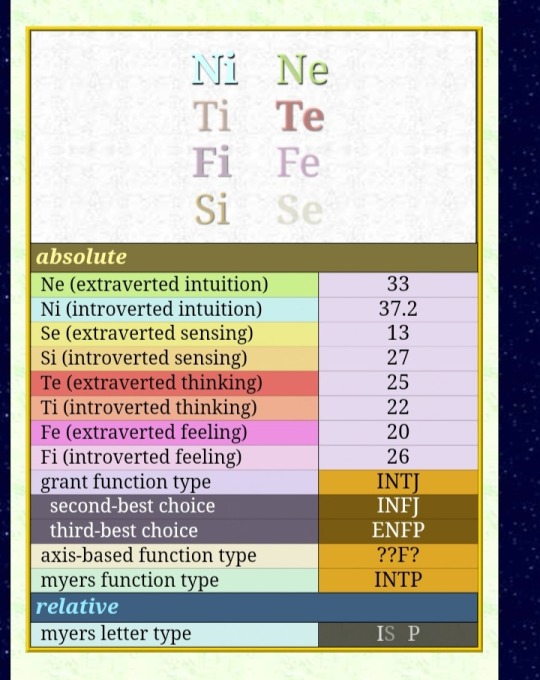
Can someone smart pretty please explain this to me
#mbti types#mbti personality types#mbti personalities#mbti#istp#enfp#intp#mbti intj#intj#myer briggs#16 personality types#personality types
58 notes
·
View notes
Text
simple (?) definitions of the functions
Edit: I made some changes (they are in italics)
Without a basic knowledge of the cognitive functions, it can be extremely hard to understand mbti. Here are the simplified definitions of the functions:
Ne (extroverted intuition): this function spreads intuition/ideas externally. The main thing Ne values is possibility. Ne wants to understand the dozens of ideas that stem from one event. It does not like to stick to one idea.
ex: when it sees a flower, it comes up with dozens of flower designs of its own. It thinks of all the possibility the flower can look like, thought Ne does not care if it is practical (or considered a “good” idea).
Ni (introverted intuition): this function forges an intuitive idea internally. Ni takes information in and thinks of one idea, one insight, on possibility. Like Ne, Ni is focused on what might be possible, not on what is tangible. It wants to dive deeper into the “truth” to find a secret meaning/contradiction.
Ex: when it sees dozens of flowers, it comes up with its own design of a flower. Unlike Ne, Ni takes its time to analyze the depth of one specific idea. Ne does not care much about the accuracy and worth of its ideas (it values possibilities more), while Ni wants its idea to be valuable.
Se (extroverted sensing): this function is focused on the external physical world around it. Se is focused on the present and what is happening in the moment. Like Si, it is focused on the small tangible details. Se is a fairly direct and objective function. It does not like to meddle with hypotheticals and theories (this does not mean Se is unintellectual). This function is a kinesthetic learner and likes to meddle with its environment.
Ex: when it sees a flower, it simply, well, sees it. It's a concrete object that has no other poetic meaning to it.
Si (introverted sensing): this function is focused on the real world in its head/internally. Si is oriented towards the past, towards repetition. It makes decisions based on how similar events in the past enrolled. Si values predictability (not necessarily tradition).
Ex: when it sees a flower, it remembers how the flower connects to past sensory details and it stores the details of the flower in its head for further use in the future.
Fi (introverted feeling): this function is focused on its own internal moral code/philosophy. It makes decisions based on how moral the situation is based on its own feelings and values. Fi is often seen as the function that wants to be authentic because it is concerned if the current situation/its decision aligns with its personal values.
Ex: when Fi gives gifts to other people, it contemplates on what gift it would like/value. Fi also analyzes how the gift would be valuable according to the person’s inner feelings and beliefs.
Fe (extroverted feeling): this function is focused on the external moral code. It is concerned if its actions align with external beliefs and ethnics. Fe makes decisions based on what the majority values. It is aware of how its actions will impact/meddle with the emotional state of other people*. Unlike Fi, Fe believes ethics are not decided by itself. Fe is objective, like Te.
*Though other functions might have this ability, Fe knows how other people feel on a “deeper level” and it is confident in its ability to do so (just like how Fi is confident in its ability to analyze its own beliefs). For example, Te might be able to analyze emotions on a surface level, but it has trouble understanding the emotions of others on an in-depth level. Plus, Te is not concerned with the emotional environment.*
Ex: when Fe gives gifts to other people, it gives gifts based on what the majority believes is the best gift.
Ti (introverted thinking): this function is focused on the logical world internally. It forges its own logical claims, reasoning and conclusions. Ti is mainly concerned with the internal consistency and analysis of one thing, rather than external evidence that supports it. Inductive reasoning. “The ball will fall because I’ve seen the same ball fall down multiple times, therefore it will fall down this time.” Ti cannot understand how one thing can contradict its own “rule”.
Ex: when Ti gives gifts, it forms an analysis on what gift would be the most beneficial based on the patterns and observations it witnesses.
Te (extroverted thinking): this function is focused on the external world of logic. It is focused on data, evidence and facts from the outside world. It is focused on if something is practical/aligns with external rules and principles. It analyzes things based on how it relates to similar external logical principles. “This ball will fall because I’ve seen other rubber balls like this fall, so it is logical to assume that this one will fall.” Deductive reasoning. Te cannot understand how one thing can contradict the “universal rule”.
Ex: when Te gives gifts, it analyzes what is the most beneficial gift by evaluating the already the existing/assumed benefits each gift option has and picks the gift with the best benefits.
#mbti#cognitive functions#16 personalities#myer briggs#explanation#intj#intp#entj#entp#infj#infp#enfj#enfp#istj#isfj#estj#esfj#istp#isfp#estp#esfp
402 notes
·
View notes
Text
MBTI for beginners (because Instagram has shit reach so posting it here.)
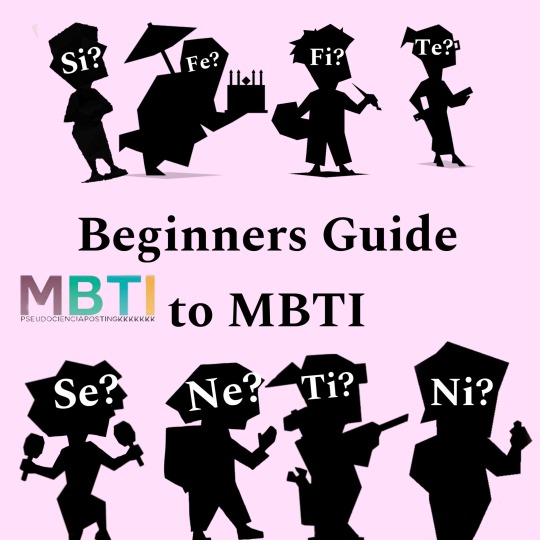
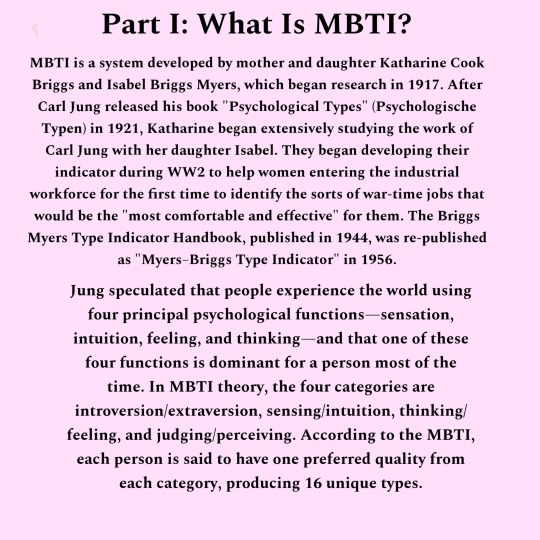

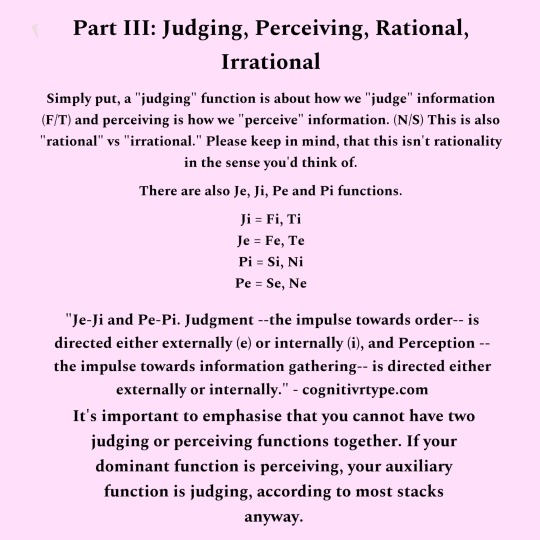
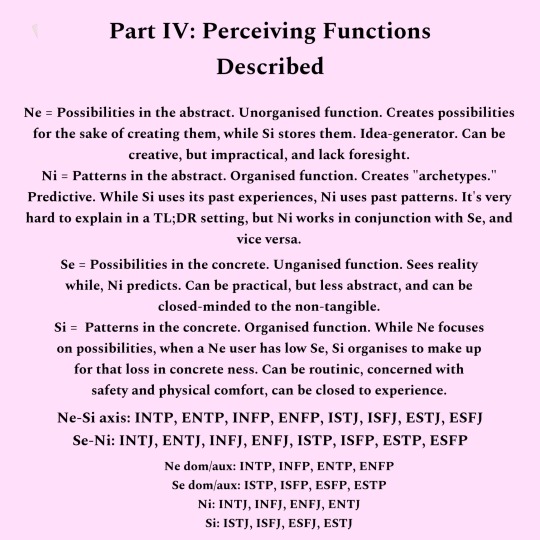

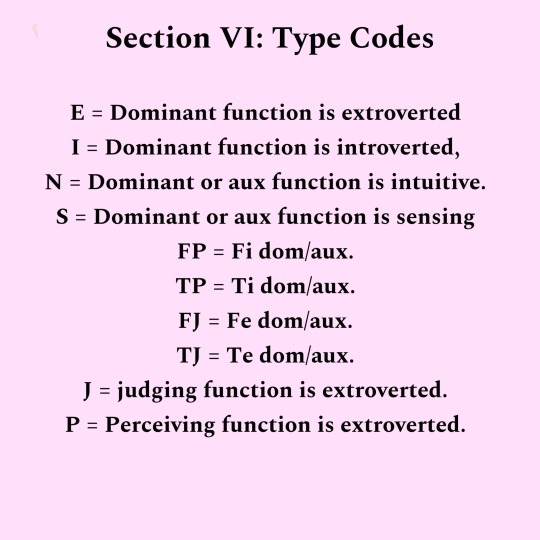
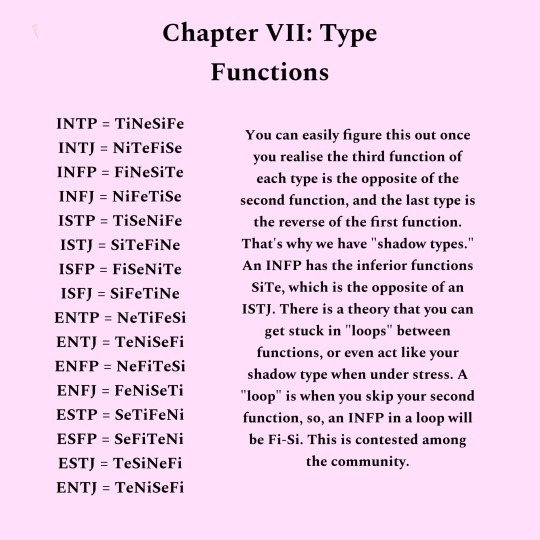
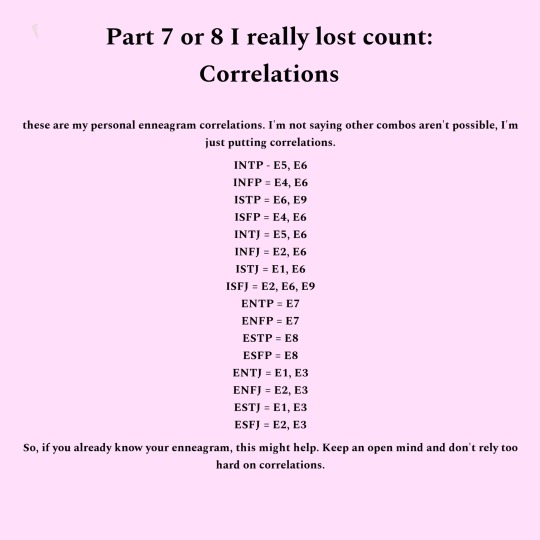
#mbti#intj#intp#entj#entp#infj#infp#enfj#enfp#istj#isfj#estj#esfj#istp#isfp#estp#esfp#lemons random rants#te dom#se dom#ne dom#fe dom#ti dom#fi dom#si dom#ni dom#myer briggs#16personalities#<is not myer briggs :)#debunking
14 notes
·
View notes
Text
Gonna start making some Moodboards of my favorite mbti characters but you guys comment your mbti types on this post so I have a starting point 😂
❤️🧡💛💚💙💜🖤🤍🤎💖
Update: Guys you have no idea how hard it’s been picking only 10 characters per type!!
Ideally I’d narrow it down to 20 at least 😂
41 notes
·
View notes
Text
INFP: Oh, no! I need an adult!
ENTP: INFP, you are the adult.
INFP: Oh.
INFP: I need an adulter adult!
#infp#mbti infp#mbti types#mbtimeme#16 personality types#incorrect mbti quotes#mbti#myer briggs#entp#mbti entp#entp x infp
256 notes
·
View notes
Text

What do you guys score on the Morality test? https://moralfoundations.github.io/
7 notes
·
View notes
Text
IxFJ explanation
[Plain text: IxFJ explanation]
IxFJ, IXFJ, I_FJ, or “The Knight”, is a personality type unrecognized by MBTI, due to MBTI's entire “superior—inferior functions” way of categorization.
An IxFJ would be someone who is both INFJ and ISFJ, which essentially means they have no superior function between sensing and intuitiveness.
Let's get more into how this would affect the personality.
ISFJs and INFJs are quite similar but one of their primary similarities is that both types seem to balance thinking and feeling.
Now, let's get into some of the differences. ISFJs are very down-to-earth and tend to have a fairly pragmatic view, they tend to have less idealistic thoughts and are often more pessimistic than INFJs due to this fact. INFJs, in contrast, are more idealistic and tend to have their head in the clouds. Another important difference between ISFJs and INFJs is that ISFJs are detail-oriented and can often get so lost in details that they fail to see the full picture. Whereas INFJs are the opposite, they see the full picture and tend to miss important details.
Taking all of this into consideration.. IxFJs are rather complex individuals. Here is a basic description followed by common traits that IxFJs may have.
IxFJ — The Knight.
IxFJs are dependable and compassionate “Knights” whose values are improvement and cooperation. They are sensitive and empathetic to others' feelings, finding an instinctual need to protect those around them from harm. They tend to remember important events in close friends' lives such as anniversaries, birthdays, and other occasions. They have a tendency to be perfectionistic, security-oriented, somewhat traditional, and lawful. They tend to prefer practicality over theoretical ideas, but theoretical ideas can be intriguing to them if backed up with what seems to be fair knowledge. They have a strong desire for self improvement and improvement for those they see fault in.
Common traits for the IxFJ:
Organized in a way which seems messy to others, practical but open to thoroughly analyzed ideals, pragmatic, disconnected and often lost in their own head, empathetic, complex, kind-hearted, nurturing, a good listener, reliable, somewhat traditional, observant, giving, loyal, protective, tend to be stuck in the present, wise, insightful, mysterious, compassionate, understanding, parental, punctual, can appear bossy and opinionated yet also a people pleaser simultaneously, usually have low self esteem, perfectionistic, dislike conflict and confrontation, tend to reminisce on their own mistakes, stubborn, resistant to change, weak boundaries, weak sense of self, doubtful that they're living up to their full potential, may overindulge in situations that can harm them, too self-sacrificial, often focus on others rather than themself, apologetic, have a warrior-like superior aura, justice-oriented.
Another addition to this: IxFJs tend to also exhibit common traits of ENTPs (debaters) and INTJs (architects) due to the clash in INFJ functions and ISFJ functions, along with functions that separately come with this type.
Good career paths for the IxFJ would include anything in these areas:
Performing arts, psychology, medical (nursing, doctor, etc), the sciences, education/teaching/mentoring, entrepreneurship.
#infj#isfj#mbti types#mbti personality types#mbti personalities#mbti#ixfj#infj personality#infj mbti#isfj personality#isfj mbti#mbti isfj#mbti infj#myer briggs#16 personalities#16 personality types#16+ personalities#16+ personality types#micro mbti
2 notes
·
View notes
Text
What is MBTI?
In simple terms, the Myers-Briggs Type Indicator or better known as MBTI, is a tool that is used to understand as well as categorise different personality types. In MBTI theory, there are four categories.
The four categories :
I or E (Where you focus your attention)
N or S (How you take in information)
T or F (How you make decisions)
P or J (How you deal with the world)
Each individual possesses a singular preference from each category. Within each category, there can only be one designation. Whether it's Introversion (I) or Extraversion (E), you inhabit one realm exclusively. This principle applies uniformly across all categories. This results in the emergence of 16 distinct and unique personality types.
For example, my preferred preference from each category is I, N, T, and P, which makes me an INTP.
Below the line, I shall explain each category simply and to the best of my abilities
1. (I)NTROVERSION or (E)TRAVERSION
The first category and primary preference pair are introversion and extraversion, depicted by the letters I and E. These facets illustrate differing energy orientations, outlining contrasting approaches to directing and receiving energy, as well as focal points of attention.
(E)TRAVERSION :
Extroversion involves a preference for social interaction, excitement, and stimulation. People who identify with Extraversion feel energized when they interact with others and the world around them. They enjoy being involved in their surroundings and getting feedback from people and events. Interacting with others and being outside recharges their social battery. They naturally focus their attention outward.
(I)TROVERSION :
Individuals who resonate with Introversion gain energy from pondering concepts and ideas within their inner thoughts. They appreciate spending focused time alone, often preferring their own space where they can tailor their surroundings. These personality types require solitude to recharge and find tranquillity. Their inner world serves as the source of rejuvenation, naturally directing their attention inward.
2. I(N)TUITION or (S)ENSING
The second set, (S)ensing and i(N)tuition, illustrate contrasting ways people perceive information and approach the world around them, shaping their responses and behaviors. They depict the perceiving mental processes for taking in information and the opposite ways to see things.
I(N)TUITION :
Intuitive individuals engage in envisioning both past experiences and future potentials based on what they perceive. Those inclined towards Intuition prioritize recognizing patterns and exploring potentialities within the information they receive. They emphasize the broader context and strive to establish connections between various pieces of information, relying on insights and gut feelings alongside their sensory experiences. Intuitives are inclined to explore imaginative ideas and possibilities, often contemplating theoretical concepts and asking "What if?" questions, as they delve into the deeper significance of things rather than focusing solely on practical matters.
(S)ENSING :
Individuals who favor Sensing direct their attention towards information that is solid and observable, emphasizing specific details and factual data. They rely on their sensory experiences to perceive the world around them, valuing practicality and direct observation. The term "real-time" resonates strongly with Observant individuals, who are deeply attuned to present circumstances and events. While they acknowledge the significance of the past and future, they primarily consider how these temporal dimensions impact their current actions, leading them to adopt a focused and pragmatic approach. Observant types prefer to engage in hands-on activities that yield tangible results, prioritizing action over abstract discussions.
3. (T)HINKING or (F)EELING
Our third category, the Nature scale, indicates our preference for either emotions or rationality when making decisions. The key distinction between thinking judgments and feeling judgments lies in the criteria they use to evaluate options.
(T)HINKING :
Individuals inclined towards Thinking prioritize objective principles and factual analysis in decision-making, relying heavily on logic and reasoning. They rely on factual information as their main tool and assess alternatives based on their logical coherence and practicality. These individuals typically approach relationships by emphasizing fairness and effectiveness, valuing respect above all else. While they may value relationships, they can sometimes overlook emotional responses, feeling uncomfortable with emotions that do not align with their rational mindset. However, this doesn't mean they lack empathy; they tend to evaluate situations rigorously.
(F)EELING :
Individuals who lean towards Feeling prioritize personal values and relationships when making decisions, often guided by their emotions and concern for others. They tend to exhibit caring, compassionate, and warm traits, demonstrating varying degrees of emotional expression. Feeling types are deeply protective of those they care about, whether it's their immediate family or broader communities in need. However, they may sometimes become overly invested in others' well-being, affecting their decision-making across various aspects of life, from personal relationships to broader societal issues. They recognize the importance of emotions and prioritize the welfare of others over cold objectivity and factual analysis.
4. (P)ERCEPTION or (J)UDGING
The fourth and final MBTI preference pair, Judging (J) and Perceiving (P), represents opposite approaches to engaging with the external world and how others perceive one's behaviors. Whether someone leans towards Judging or Perceiving influences their outward focus and energy expenditure, reflecting their inclination towards interacting with people, events, and situations in the external environment. Regardless of one's preference for Extraversion or Introversion, everyone exhibits both extraverted and introverted aspects of their personality at different times, either through decision-making processes (Judging) or information gathering (Perceiving). Therefore, individuals tend to introvert the process that they do not extravert, reflecting a balanced engagement with both internal and external dynamics.
(J)UDGING :
Individuals who favor Judging prefer a structured and organized lifestyle, seeking control over their environment by creating plans and adhering to them. They primarily engage with the outside world through their decision-making processes, whether through Thinking or Feeling. Closure and decisiveness are significant for those with a Judging preference, as they feel most at ease when they have a clear path forward. They prioritize preparation and adherence to plans, preferring clarity and finality over spontaneity. While this trait can sometimes lead to rigidity, most individuals with a Judging preference are not unreasonably stubborn, recognizing the need to adapt to unforeseen circumstances. However, too many surprises can cause frustration and stress for them. Judging types typically exhibit a strong work ethic, prioritizing duties and responsibilities, and emphasizing adherence to rules and standards for achieving success, driven by a sense of fairness and a desire for tangible results.
(P) ERCEPTION :
Individuals who prefer Perceiving, also known as Prospecting, embrace a flexible and open-ended lifestyle, preferring to explore options rather than exert control over their environment. They primarily engage with the outside world through their information-gathering processes of Sensing or Intuition. Remaining open to new information, last-minute opportunities, and being adaptable are central to those with a Perceiving preference. Prospecting individuals excel at dealing with unexpected challenges and seizing opportunities, reacting to their surroundings rather than trying to control them, which allows them to make the most of whatever circumstances they encounter. While their openness to possibilities can lead to impulsive decision-making and difficulty committing due to the abundance of options, it also fosters creativity and productivity. Their minds constantly generate a myriad of options, akin to a stream of consciousness, enabling them to find innovative solutions and explore a variety of interests. Despite potential challenges such as indecision and perceived unfocus, the Perceiving trait facilitates a dynamic and stimulating approach to life, characterized by a continual exploration of diverse opportunities.
Your dominant preference from each pair highlights your potential strengths. While you primarily rely on certain preferences, you still utilize others to varying degrees, akin to your hand preference where one hand is favoured, but both are used. Occasionally, you'll need to tap into less preferred preferences, which may present challenges, known as a personality stretch. Understanding your strengths and stretches aids in self-awareness, enhances interpersonal understanding, and fosters personal growth. These preferences don't operate independently; when combined, they form the 16 MBTI personality types, offering a comprehensive understanding of personality dynamics and development.
The 16 personalities can also be categorised into groups (with their respected colours) :
Analysts : INTJ, INTP, ENTJ, ENTP
Diplomats : INFJ, INFP, ENFJ, ENFP
Sentinels : ISTJ, ISFJ, ESTJ, ESFJ
Explorers : ISFP, ISTP, ESFP, ESTP
These groups are not important when it comes to understanding the basics of MBTI. Nonetheless, those are all the types.
All information (none of which is my own) was accessed through these websites :
Feel free to read more about MBTI through these websites or others to gain a better understanding. What I have used from these websites are the BASICS. I am no professional after all lol. I hope it's not that confusing. I tried to use the information that most applied in a simple way. Sorry if it does not come across as so.
Following this, I shall be typing the characters in Dead Poets Society. This is for those who don't have an understanding of MBTI.
#dead poets society#charlie dalton#todd anderson#neil perry#dead poets edit#dead poets fanart#dead poets honor#dead poets memes#mbti personalities#mbti personality types#mbti types#mbti#myer briggs#intp#entp#intj#entj#infp#enfp#infj#enfj#isfp#esfp#isfj#esfj#istj#estj#istp#estp#dead poets live
6 notes
·
View notes
Text
youtube
Watch the American Climate Leadership Awards 2024 now: https://youtu.be/bWiW4Rp8vF0?feature=shared
The American Climate Leadership Awards 2024 broadcast recording is now available on ecoAmerica's YouTube channel for viewers to be inspired by active climate leaders. Watch to find out which finalist received the $50,000 grand prize! Hosted by Vanessa Hauc and featuring Bill McKibben and Katharine Hayhoe!
#ACLA24#ACLA24Leaders#youtube#youtube video#climate leaders#climate solutions#climate action#climate and environment#climate#climate change#climate and health#climate blog#climate justice#climate news#weather and climate#environmental news#environment#environmental awareness#environment and health#environmental#environmental issues#environmental justice#environment protection#environmental health#Youtube
6K notes
·
View notes
Text

ENFP & ENTP 🥰❤️😈
Illustrations of the MBTI couple.

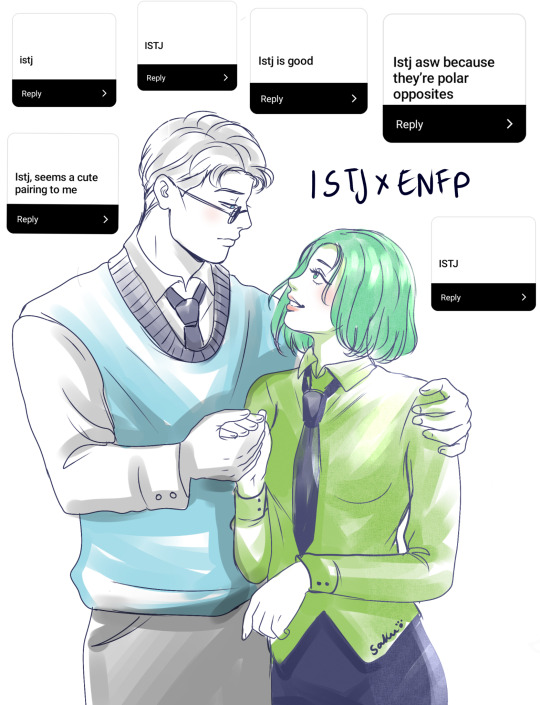

I honestly didn't expect this ! but so many voted for these two and now I ship it too, they are a good match, I feel like they'll make a fun couple and complete each others 💙 I hope you like it !
Who's next ? 🤔
#mbti#16 personality types#16 personalities#16 personalidades#artist on tumblr#enfp#entp#intj#istj#enfp x intj#enfp x entp#enfp x istj#myer briggs#fan art#myart#mbti fanart
355 notes
·
View notes
Text
mbti is astrology for people who are just so fucking annoying
#mbti#mbti memes#astrology#mbti personality types#16 personalities#myer briggs#zodiac#zodiac signs#astrology memes#astrology posts#astrology observations#horoscope#mbti personalities#mbti types#astro observations#astrology notes#mbti stuff#mbti humor
142 notes
·
View notes
Text
hi !! i’m an ESTP who’s into typology. i desperately want to bring more awareness to sensor types and also just explain the nuance of my cognitive stack (because i feel my functions are very easily misunderstood in the community, especially Ni) so let’s interact and get along :)
9 notes
·
View notes
Text
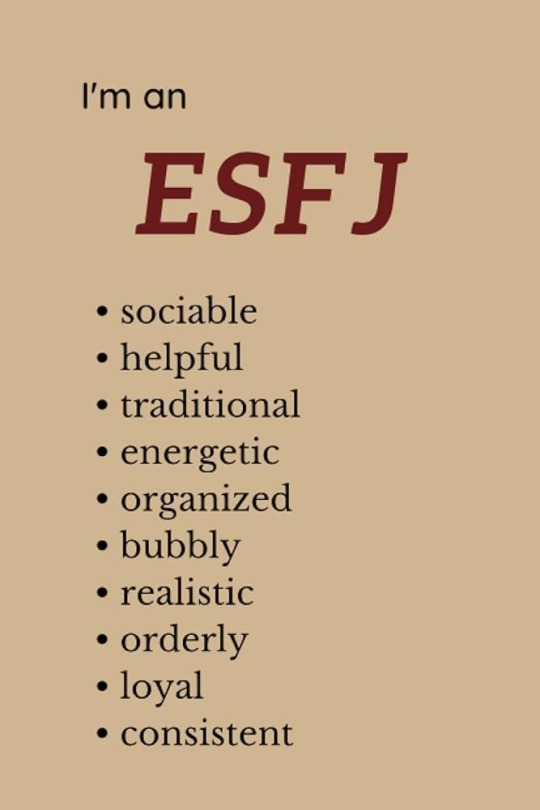

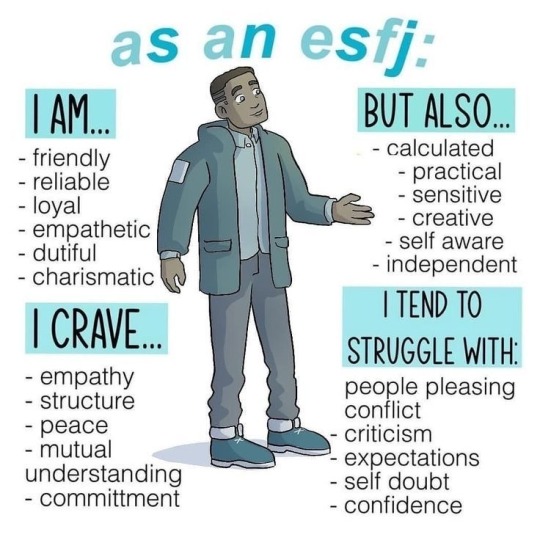


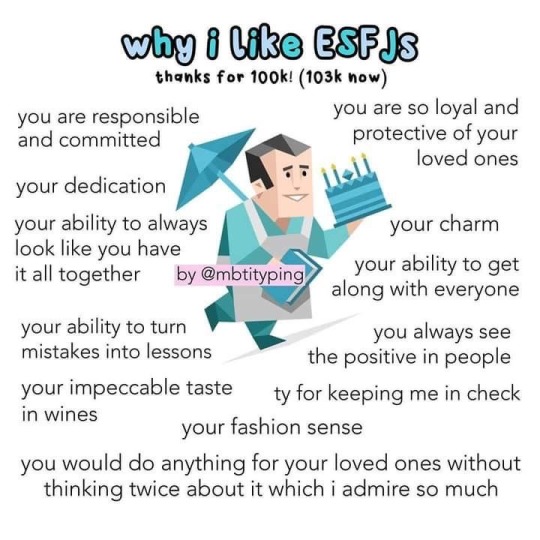

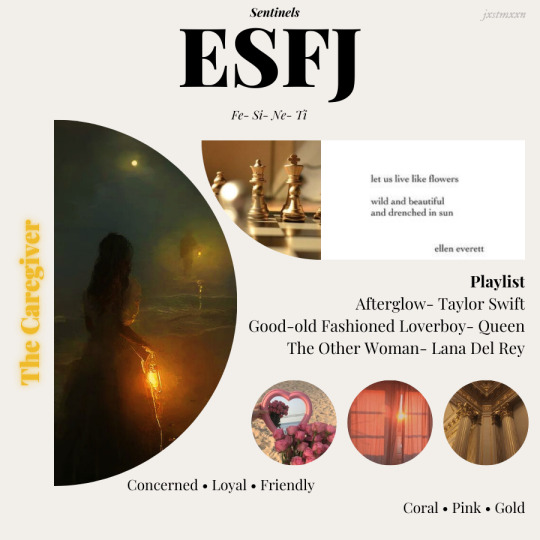
🌸✨🛍️ESFJ 🛍️✨🌸
3 notes
·
View notes
Text
ENTP, sprinting to a nearby shelter: INFP, run! It's raining!
INFP, calmly enjoying the rain: What's the hurry for? We're already soaked, anyways.
#infp#mbti infp#mbti types#mbtimeme#16 personality types#mbti#incorrect mbti quotes#myer briggs#entp#mbti entp#entp x infp
137 notes
·
View notes